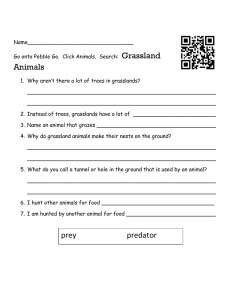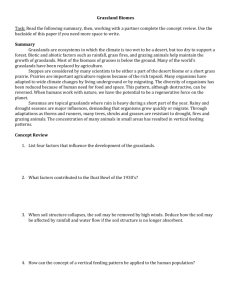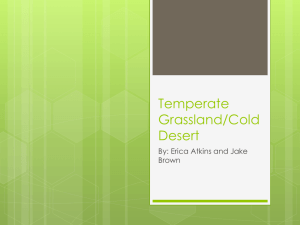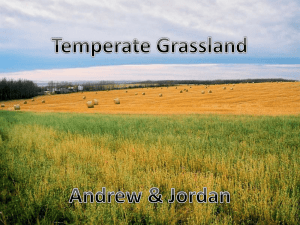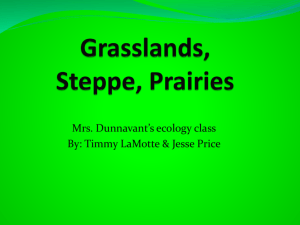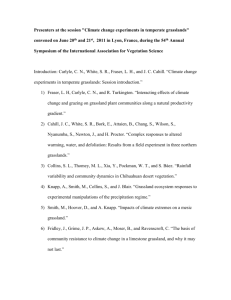4.2 Fire in grasslands and prairies.
advertisement
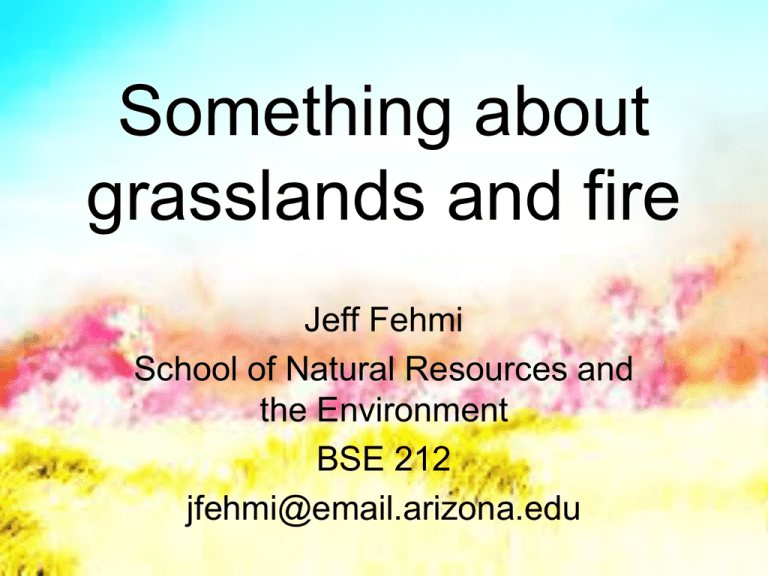
Something about grasslands and fire Jeff Fehmi School of Natural Resources and the Environment BSE 212 jfehmi@email.arizona.edu Wikipedia notes • Most abundant and widely distributed plants on earth – grass covers 20-30% of the land. • Grasses provide more than 50% of the direct calories consumed by humans and 70% of crops are grasses. Beer. • Been around since dinosaurs • Evolved in step with grazers • Through most of their history, they were tropical understory plants. Woody plants http://texastreeid.tamu.edu Dicot herb http://hawaii.hawaii.edu/laurab/generalbotany/images/seed%20germination.jpg msuweeds.com gardeninggarden.com chilli-willy.com What is the lifecycle of a grass plant? http://forages.oregonstate.edu/projects/regrowth/main.cfm?PageID=67 Adaptation to grazing • Leaves elongate from the base instead of the tip. • Leaves contain opal phytoliths http://www.geog.umn.edu/Faculty/brown/grasslands/Phytolith0.htm http://etc.usf.edu/clip art/41400/41438/teet h_41438.htm http://www.sciencedirect.com/science /article/pii/S1040618211006665 getfreewallpapers.net ehow.com reynoldspest.com fao.org guyanagrenier.wordpress.com Photos.com What are grasslands? http://www.bio.miami.edu/ecosummer/lectures /lec_biomes.html • Four terrestrial biomes- http://www.bio.miami.edu/ecosummer/lectures /lec_biomes.html • • • • Tundra Desert Grassland Forest I also add • Shrublands • Savannas Where do they occur in the world? http://www.millenniumassessment.org/documents/document.291.aspx.pdf http://www.bcgrasslands.org/library/world.htm Figure 12.1 Map showing location of grassland sites and boundaries of Bailey ecoregions representing grasslands worldwide. N .indicates sites used in the initial parameterization of different grassland ecosystems in various ecoregions (see Parton et al. 1996, Chapter 11 this volume) http://www.icsu-scope.org/downloadpubs/scope56/Chapter12.html http://img127.imageshack.us/i/climatemapworldrn6.png/ Why grasslands? Why not forests or shrublands or savannas? • Could woody plants grow there? http://npnrd.org http://coopext.colorado.edu • People disagree: – Disturbance caused – Result from climate and shallow soil Fire on grasslands • Fires like grasses They have a long history together. • Grasses like fires • Fire effects are variable: – When it occurs – How hot it is – How often it occurs – What was there before the fire – What grew/happened after the fire Grasslands depend on disturbance – Fire – Grazing http://reveg-catalog.tamu.edu/06-Fire.htm – Environmental – Recreation – Management (mowing/herbicides) http://www.livestockforlandscapes.com/goats.htm http://en.wikipedia.org/wiki/Tree_line http://en.wikipedia.org/wiki/Flood-meadow What is the fate of uneaten herbaceous litter? • Fig. 1A Theory predicts that litter decomposition declines exponentially over time and the largest mass loss occurs in the first few years. Data for Nebraska http://csp.unl.edu/public/G_decomp.htm clbrowningranch.org http://www.climatechange.umaine.edu/Research/Contrib/images/13fig1.jpg Fire and Grazing • combine to increase diversity. • Patchiness is good and fire and grazing together make things patchy which benefits plants, animals, birds, insects, etc. http://fireecology.okstate.edu/patch_burning__ heterogeneity.html maine.gov

